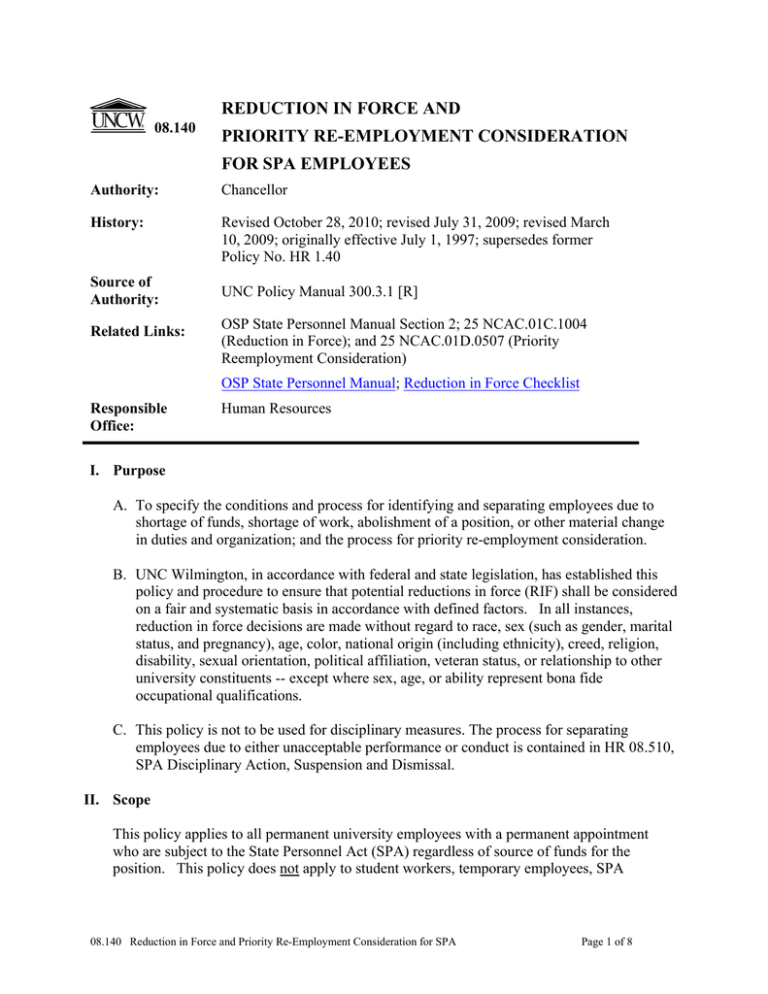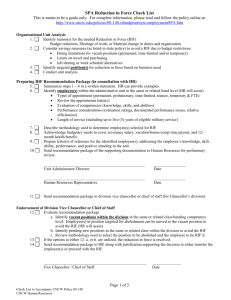REDUCTION IN FORCE AND PRIORITY RE-EMPLOYMENT CONSIDERATION FOR SPA EMPLOYEES
advertisement

REDUCTION IN FORCE AND 08.140 PRIORITY RE-EMPLOYMENT CONSIDERATION FOR SPA EMPLOYEES Authority: Chancellor History: Revised October 28, 2010; revised July 31, 2009; revised March 10, 2009; originally effective July 1, 1997; supersedes former Policy No. HR 1.40 Source of Authority: Related Links: UNC Policy Manual 300.3.1 [R] OSP State Personnel Manual Section 2; 25 NCAC.01C.1004 (Reduction in Force); and 25 NCAC.01D.0507 (Priority Reemployment Consideration) OSP State Personnel Manual; Reduction in Force Checklist Responsible Office: Human Resources I. Purpose A. To specify the conditions and process for identifying and separating employees due to shortage of funds, shortage of work, abolishment of a position, or other material change in duties and organization; and the process for priority re-employment consideration. B. UNC Wilmington, in accordance with federal and state legislation, has established this policy and procedure to ensure that potential reductions in force (RIF) shall be considered on a fair and systematic basis in accordance with defined factors. In all instances, reduction in force decisions are made without regard to race, sex (such as gender, marital status, and pregnancy), age, color, national origin (including ethnicity), creed, religion, disability, sexual orientation, political affiliation, veteran status, or relationship to other university constituents -- except where sex, age, or ability represent bona fide occupational qualifications. C. This policy is not to be used for disciplinary measures. The process for separating employees due to either unacceptable performance or conduct is contained in HR 08.510, SPA Disciplinary Action, Suspension and Dismissal. II. Scope This policy applies to all permanent university employees with a permanent appointment who are subject to the State Personnel Act (SPA) regardless of source of funds for the position. This policy does not apply to student workers, temporary employees, SPA 08.140 Reduction in Force and Priority Re-Employment Consideration for SPA Page 1 of 8 employees with time limited appointments, faculty, or any other employees exempt from the State Personnel Act (EPA). III. Policy A. The university makes reasonable effort to avoid involuntary separation of permanent employees. Therefore, temporary, probationary, or trainee employees in their first six months of employment in the same work unit (as determined by similarity of job content, unity of mission, or proximity of workers) shall not be retained in classes where permanent employees must be separated in the same or related classification band competency level. B. Reduction in force is at the sole discretion of the university and is not a decision on the part of the employee(s). C. The effect of the analysis at the work unit level is that the employee in the targeted position possibly may not be the employee separated through the reduction in force. Following the analysis and priority determinations, another employee may be identified for reduction in force instead, and the resulting vacancy would be filled through reassignment of the employee who was in the original targeted position. D. If a position is reduced from full time to part time resulting in an economy in the State Budget, the employee in the position may choose to be reduced in force, with the rights and benefits provided by policy, in lieu of accepting the reduced hours. E. The reduction in force procedure for SPA employees provides equitable treatment for the separation of SPA employees when reduction in force becomes necessary. A reduction in force decision based on financial reasons should be reached only after measures such as a hiring freeze on vacant positions, limits on purchasing and travel, and job sharing or work schedule alternatives have been considered. F. If a general reduction in operating funds affects the university, UNCW may elect to meet its reduction obligation by prioritizing campus needs. For example, the university may first reduce staff positions in areas outside the academic core to preserve instruction, research, or student services positions. The university may also exempt safety, health, or other such critical positions from a reduction order. IV. Work Unit Analysis and Recommendation A. To determine which position(s) within the identified work unit are subject to a reduction in force, a thorough analysis of the operational need for particular positions must occur (in consultation with Human Resources) in order to assure the university can provide the highest level of service possible with a reduced workforce. Such an evaluation must include: 1. Determination of the number of positions which must be abolished; 08.140 Reduction in Force and Priority Re-Employment Consideration for SPA Page 2 of 8 2. Feasibility of eliminating entire programs or parts of programs; 3. Identification of areas where the number of positions must be reduced or eliminated; and 4. Identification of the classification (banded classification and competency level) of positions to be eliminated and a determination of whether sufficiently similar vacant positions within the work unit exist to utilize employees who would otherwise be separated. B. After specific positions are identified, comparisons between employees in the same or related band are made. The analysis must include a systematic consideration, at a minimum, of the following factors: 1. Employees’ types of appointments; 2. Employees’ relative efficiencies. This includes an evaluation of the relative competencies (knowledge, skills, and abilities) and documented performance evaluation of the recommended employee(s) and all others in related classification bands in the work unit in comparison to operational need. 3. Employees’ length of service (which may include up to five (5) years of eligible military service). 4. An impact analysis of proposed reduction in force on the work unit’s demographics. C. At least six weeks prior to the anticipated separation date of any employee for purposes of reduction in force, the director or department head must submit a written recommendation to Human Resources via the appropriate vice chancellor or chief of staff. Human Resources is responsible for further analysis before authorizing the final university decision. D. The written recommendation must include the analyses described in IV.A and B, a description of measures taken to avoid a reduction in force, and the method by which a specific employee or employees are identified for being reduced in force. The result may necessitate some reassignments within the work unit prior to the final recommendation regarding the identified employee(s). E. In addition to the recommendation to separate, the department prepares a letter of reference for the identified employee(s), addressing the employee’s knowledge, skill, ability, performance, and positive standing in the department. V. Endorsement of Vice Chancellor or Chief of Staff 08.140 Reduction in Force and Priority Re-Employment Consideration for SPA Page 3 of 8 A. The division vice chancellor or chief of staff for the Chancellor’s Division must decide whether to endorse the recommendation to separate the identified employee(s) from his or her current position(s) under this policy. This would include the review of other employees within the identified work unit in like positions. B. The vice chancellor or chief of staff must then evaluate the education, experience, and competencies of the employee to be separated and determine if: 1. another position could be created within the division in order to avoid the reduction in force; or 2. the employee could be transferred into a suitable vacant position (for which an offer has not been extended) within the division to avoid the reduction in force. C. If either of the options in V.B. are available, the employee is placed and the reduction in force is resolved. If neither option exists, the vice chancellor or chief of staff must document the basis for his or her decision to endorse the reduction in force, and forward the recommendation to Human Resources. VI. Human Resources Final Review and Notice of Separation A. Upon receipt of an endorsement from the vice chancellor or chief of staff, Human Resources ensures: 1. the justification for a reduction in force has considered all the necessary factors; and, 2. the decision is made in compliance with the university’s EEO/AA plan and policy, and applicable federal law. B. Upon completion of this review, the director of Human Resources, on behalf of the chancellor, notifies the vice chancellor, chief of staff, or their designee of the decision. 1. If the reduction in force is found to be compliant, Human Resources prepares the official notice of separation letter and authorizes the vice chancellor or delegate to issue the letter to the employee. The employee must receive the letter at least thirty (30) calendar days before the date of separation. 2. If the reduction in force is found to be non-compliant, Human Resources will discuss options and alternatives with the appropriate administrator. C. After delivery of the notification letter, a Human Resources representative will meet with the employee to inform him or her of priority re-employment rights, eligibility for severance or discontinued service retirement, unemployment insurance eligibility, leave payouts, and health insurance continuation. VII. Reassignment to Avoid Separation 08.140 Reduction in Force and Priority Re-Employment Consideration for SPA Page 4 of 8 A. Once the notice of separation letter from the division is issued to the employee, Human Resources attempts to find a suitable vacant position in any other division for the employee to avoid the separation. [The employee’s salary level must be maintained in such reassignments unless the salary exceeds the maximum of the band set by state policy.] A suitable vacant position is one: 1. that is in the same banded classification at the same or lower competency level as is currently held or for positions in a different banded classification with the same or lower journey market rate as is currently held, 2. for which the employee meets minimum qualifications, 3. and the employee could perform the job within nine months, including normal orientation and training given any new employee, and 4. is the same FTE. B. When Human Resources identifies a vacancy that appears to be suitable, Human Resources reviews the employee’s qualifications against the position’s requirements to determine if the employee meets the minimum qualifications. 1. If a vacancy is either not advertised or advertised but applications have not been referred, the employee’s application is forwarded to the department. This referral requires more consideration than other applicants. The department is expected to interview and hire the employee if the employee meets the minimum qualifications for the position and can perform the job within nine months, with normal orientation and training given any new employee. If the department does not believe that the individual can perform the job duties, the department must document the reasons and forward this documentation to both the division vice chancellor or chief of staff and Human Resources for review and consideration. 2. If a position has been advertised and applications have already been referred, but a recommendation for hire has not been received by Human Resources, Human Resources forwards the employee’s application to the department. The employee has priority re-employment consideration over non-state employees. The department is expected to interview and hire the RIF candidate, over any non-state (SPA) employee, if the RIF candidate meets the minimum qualifications for the position and can perform the job within nine months, with normal orientation and training given any new employee. If the department does not believe that the individual can perform the job duties, the department must document the reasons and forward this documentation to both the division vice chancellor or chief of staff and Human Resources for review and consideration. 3. If, after reviewing the departmental documentation, the division vice chancellor or chief of staff and Human Resources determine that the employee meets the minimum 08.140 Reduction in Force and Priority Re-Employment Consideration for SPA Page 5 of 8 qualifications for the position and could perform the job within nine months, the university is required to place the employee in the position in order to avoid the reduction in force. VIII. Priority Re-Employment following Separation A. Priority re-employment is only afforded to “career status” state employees who have been separated due a reduction in force and have not retired. Priority re-employment rights extend for twelve (12) months* from the date of written notification of a reduction in force (*unless legislatively extended). A career status state employee is one who is in a permanent position appointment and has been continuously employed by the state of North Carolina in a position subject to the State Personnel Act for the immediate preceding twenty-four (24) months. B. A RIF state employee shall have priority for positions in the same banded classification at the same competency level or lower as held at the time of notification, or for positions in a different banded classification with the same or lower journey market rate as held at the time of notification. C. A RIF state employee with more than ten (10) years of service shall receive priority consideration over a RIF state employee with less than ten (10) years of service in the same or related position classification band competency level. D. Once the career state employee is separated (not retired) from the university, priority reemployment consideration over non-state (non-SPA) applicants is afforded for the duration of eligibility. However, to receive this consideration, the employee must apply for the vacancy prior to the deadline date. E. Due to this stated required priority, if the RIF state employee meets minimum qualifications for the position, the individual’s application is forwarded to the department along with those of other current SPA employees with permanent or time-limited appointments. If the department does not hire the referred RIF priority candidate or any other current state employee, the department must document the reasons for nonselection. If such documentation is sufficient to meet state requirements, Human Resources would then refer the most qualified applications from among the pool of nonstate (SPA) applicants. IX. Continuation of Priority Re-Employment Rights If a career banded employee accepts a position that has the same banded classification and a lower competency level, salary rate, or appointment status than that held at the time of RIF notification, or if the employee accepts a position that has a different banded classification with a lower journey market rate, salary rate, or appointment status than that held at the time of notification, the priority reemployment consideration will continue for the remainder of the re-employment priority period or until priority is otherwise satisfied. 08.140 Reduction in Force and Priority Re-Employment Consideration for SPA Page 6 of 8 Otherwise, an employee may accept the following employment and retain priority consideration throughout the re-employment priority period: A. employment outside State government, B. a State position not subject to the State Personnel Act, or C. a temporary position, or D. a contractual arrangement. X. Loss of RIF status and Priority Re-employment rights An employee, after receiving RIF notice of separation, who does any one of the following forfeits RIF priority status, including any remaining severance salary continuation, benefits continuation, and re-employment priority: A. refuses an interview or offer for a position within 35 miles of the employee’s original work station if the position is at a the same banded classification and has a competency level, salary rate, and appointment status equal to or greater than that held at the time of notification; or B. refuses an interview or offer for a position within 35 miles of the employee’s original work station if the position is at a different banded classification and has a journey market rate, salary rate, and appointment status equal to or greater than that held at the time of notification; or C. accepts a position at the same banded classification equal to or greater than the competency level, salary rate, and appointment status of the position held at the time of notification; or D. accepts a position at a different banded classification equal to or greater than the journey market rate, salary rate, and appointment status of the position held at the time of notification; or E. has received priority re-employment consideration for the legislatively prescribed period, or F. accepts a position with the same banded classification at a lower competency level and/or lower salary rate and is subsequently terminated by disciplinary action. G. accepts a position with a different banded classification at a lower journey market rate and/or lower salary rate and is subsequently terminated by disciplinary action. XI. Severance Salary Continuation A permanent, full-time or part-time (20 hours per week and over) employee who does not obtain another permanent job as a state employee by the effective date of the reduction in force may be eligible for severance salary continuation provided reemployment is not available. Severance pay does not apply to employees who are probationary; who are separated at the end of time-limited appointments; whose reduction in force is temporary; or who are separated due to retirement. Years of service, age, reemployment, retirement, and funding as directed by the Office of State Budget and Management affect severance. XII. Leave Balances 08.140 Reduction in Force and Priority Re-Employment Consideration for SPA Page 7 of 8 A. Vacation Leave. Employees will be paid a lump sum for the balance of their vacation leave at the time of separation not to exceed 240 hours. If an employee has over 240 hours of vacation leave at the effective date of separation due to reduction in force, the excess leave will be reinstated if the employee is reemployed by the state within one year. B. Sick Leave. An employee’s sick leave balance at the time of separation due to reduction in force will be reinstated if the employee returns to state employment within five years. XIII. Discontinued Service Retirement Employees notified of a reduction in force with: (a) 20 or more years of creditable retirement service, and who are age 55 or older (no reduction in benefits); or (b) who have 20 or more years of creditable retirement service, and who are age 50 or older (benefits reduced by ¼ of 1 percent for each month under age 55), might be eligible for discontinued service retirement. Employees should contact the Salary and Benefits Manager in Human Resources to obtain more information about their specific retirement eligibility. XIV. Health Insurance Employees with at least one year of state service who are participating in the State Health Plan at the time of separation due to a reduction in force will receive university-sponsored individual health insurance coverage for one year from the date of separation or until reemployed in another permanent state position, whichever is sooner. Dependent coverage is not included but may be purchased by the employee. XV. Appeals A career state employee with priority status separated through a reduction in force may appeal that separation if it is alleged the separation is in retaliation for the employee's opposition to alleged discrimination on account of the employee's age, sex, race, color, national origin, religion, creed, political affiliation or disability or if it is alleged there was a denial of veterans preference. Such an appeal may be made in accordance with HR policy 08.520; SPA Employee Appeals and Grievances, or may be filed directly with the State Personnel Commission through established procedures of the Office of Administrative Hearings, at the choice of the employee (except that allegations of sexual orientation discrimination may be appealed only through the university procedure). 08.140 Reduction in Force and Priority Re-Employment Consideration for SPA Page 8 of 8


